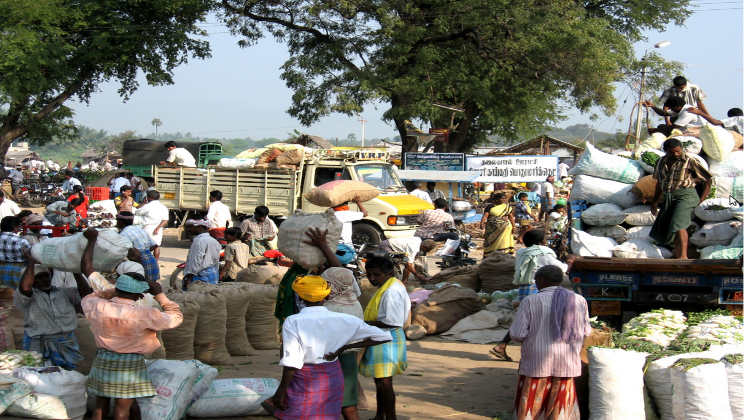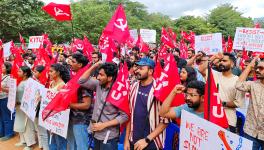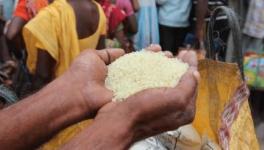Minimum Wage and the Poverty Line

Image Courtesy: wikimedia.org
The criteria for determining the minimum wage have evolved in India over a long period of time. The basic guidelines set at the Indian Labour Conference have been subsequently improved upon by the Supreme Court in the early 1990s. As of now, the principles for setting the minimum wage after all these modifications stand as follows.
The basic family unit for which the calculation is made is supposed to consist of four persons, a husband, wife and two children. These two children together constitute one consuming unit, so that one can say that the family has three consuming units altogether. Each consuming unit is supposed to consume 2700 calories per day. In addition each family is supposed to have access to 72 yards of cloth per year. Suppose the total expenditure per year, on food that would give 2700 calories per consuming unit per day, and on 72 yards of cloth for the year as a whole, comes to an amount Rs X. Then 10 percent is added to Rs X as house-rent and 15 percent for other expenditure. In the early 1990s the Supreme Court added a further 30 percent of Rs X as additional expenditure on other heads. Altogether therefore, as matters stand, it is Rs X plus 55 percent of it over and above Rs X, which constitute the minimum annual wage that is supposed to maintain a family of four.
The exact sum that this minimum wage translates itself into would of course depend upon the prevailing prices, and hence would vary from year to year. But the point is that the principle for estimating this minimum wage is not arbitrary and whimsical but arrived at after considerable and careful deliberations.
Missing the point
Some may wonder why only one person is assumed to be working for a wage in a family so defined; why should not both the adults in the family be assumed to be working? This however misses the point that the other adult who is not assumed to be employed for a wage is not idle but engaged in a whole range of activities like cooking, looking after the children and other domestic chores which are essential for the family but earn no wage. If both adults in a family are assumed to work, then someone else will have to be employed by the family to do the cooking and other chores that one of the adults was doing earlier, which correspondingly would raise the minimum wage too. Hence the assumption that only one of the members of the family is employed and must earn enough to cover the entire family’s minimum material requirements is the correct one in the prevailing circumstances, when the State does not provide the range of services gratis to the family that one of its members is currently expected to perform. It is for this reason that the Indian Labour Conference set out the basic criteria for arriving at the minimum wage that should be able to support a family of four.
On this basis, the recent Central Pay Commission fixed the monthly minimum wage for central government employees whose work requires no special skills at Rs18,000. And using the perfectly legitimate principle of “equal pay for equal work”, the trade unions which went on strike on September 2, demanded that unskilled workers must also get the same monthly minimum wage. On the assumption of a 26-day working month (which itself is rather longer than for central government employees), this works out to Rs 692 per working day.
Yet, despite the fact that the calculations are “official” (made by none other than the Central Pay Commission whose recommendations have been accepted by the central government), and also the fact that the extension of the same figure to workers elsewhere is based on the principle of “equal pay for equal work” which none should object to, the Modi government rejected the trade unions’ demand and offered instead a minimum wage that was only a fraction of what the Central Pay Commission had fixed. It even tom-tommed what it offered as a great concession and accused the unions of being unnecessarily intransigent. The trade unions however stuck to their perfectly justifiable demand and went on a strike that was remarkably successful and unprecedented in its scale.
Fraudulent method
This calculation which has an official stamp, even though the government maliciously and illegitimately differentiates between different groups of workers in implementing the minimum wage, has an obvious relevance for the estimate of the poverty-line as well. The poverty line in India is defined as that level of expenditure at which a daily calorie intake of 2200 calories per person is reached in rural India and of 2100 calories per person is reached in urban India. These poverty lines were calculated for the base year 1973-74, and were then brought forward for subsequent years using a consumer price index.
The alternative method would have been to make a fresh calculation for each subsequent year at five-yearly intervals (when fresh calorie intake data become available), exactly as was made in the base year, to arrive at a new poverty line for each such year. This latter would in fact have been the obvious legitimate method; but the former gave a much lower figure for the poverty-line because of the infirmities of the price-index, and hence for the head-count ratio of poverty. Hence, though it was fraudulent, the government gleefully accepted it. And what is more, the excess of the correct estimate of the poverty-line over what the fraudulent method gave, kept increasing over time, because of which the government could make the spurious claim that poverty was declining in the country, while in reality the opposite was happening.
So absurd had the official poverty line, calculated by this fraudulent method, become, that a number of subsequent committees were set up to increase it in all sorts of arbitrary ways, in order to give it a semblance of credibility, even while carefully sustaining the official myth that the head-count ratio of poverty had been declining in the country.
What is noteworthy about the minimum wage calculation however is that the calorie norms assumed for it are lower than for the poverty-line. The norm of 2700 calories per consuming unit assumed for the minimum wage calculation comes to 8100 calories for the family as a whole (since there are only three consuming units), which works out to a per capita intake of 2025 calories per day. This is lower than the calorie norm for defining poverty whether in rural or in urban India. (The calorie norms of 2200 and 2100 it should be remembered are defined not for “consuming units” but for natural units of the population). Hence, if we assume that the ratio between food and non-food expenditures is the same for fixing the poverty line as it is for fixing the minimum wage, then it follows that the poverty-line should exceed the minimum wage, ie, should exceed Rs18000 per month.
Some no doubt would object to this assumption: why should the food-non-food expenditure ratio be the same in the two calculations? But since the daily calorie norms, 2200 for rural India and 2100 for urban India, are arrived at “objectively”, there is no reason why the other expenditure norms for defining the poor should also not be “objectively” fixed, as they are in the case of minimum wage calculations. In fact it is a better way to arrive at the poverty-line than even what I have called the “correct method” above (that was used only in the base year), of relying on the expenditure decisions of households. And if we do so then the poverty-line should exceed the minimum wage.
But let us err on the conservative side and assume that the poverty-line is the same as the minimum wage, ie, Rs18000 per month for a family of four, which amounts to Rs 600 per day for the family and Rs150 per day per capita. This is more than double the official adjusted poverty-line, ie, not the official figure that is based simply on bringing forward the base year figure through a price-index, but the one that has been recommended by the Rangarajan Committee, the last of the several committees appointed by the government to bring some credibility to the poverty-line estimate.
It is worth recalling that in 2012, the Chinese government nearly doubled the poverty-line in that country in order to include many more people within the ambit of schemes meant to benefit the “poor”. The argument for doubling the poverty-line in China was not elaborated. But in India, it seems that even on the basis of careful calculations, such as those made by the Central Pay Commission, there is an overwhelming case for at least doubling the poverty-line. It would of course give the lie to government claims about low or declining poverty, but it would have the effect of bringing numerous destitute working people, who are currently excluded, into government schemes meant for the poor.
Disclaimer: The views expressed here are the author's personal views, and do not necessarily represent the views of Newsclick
Get the latest reports & analysis with people's perspective on Protests, movements & deep analytical videos, discussions of the current affairs in your Telegram app. Subscribe to NewsClick's Telegram channel & get Real-Time updates on stories, as they get published on our website.
























